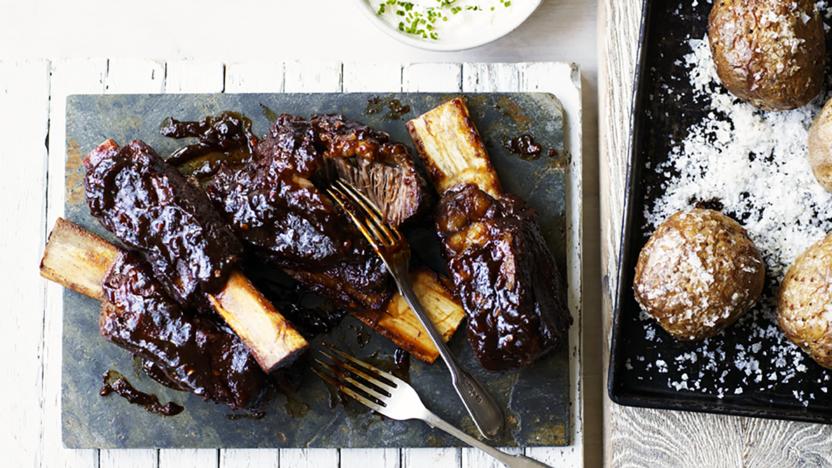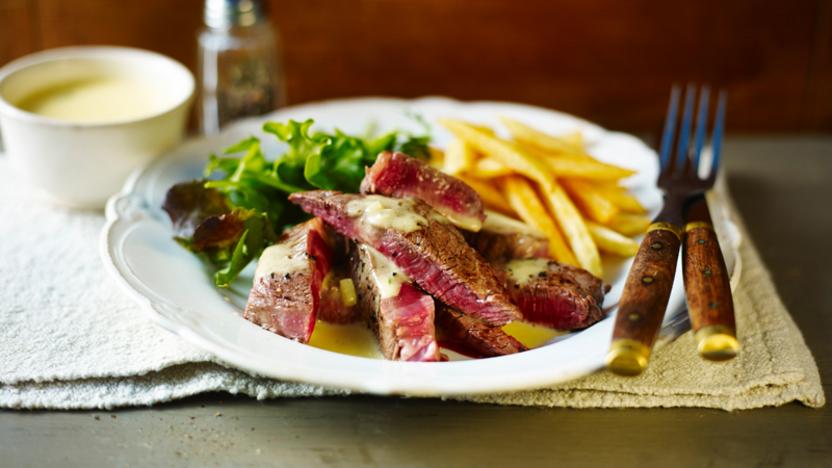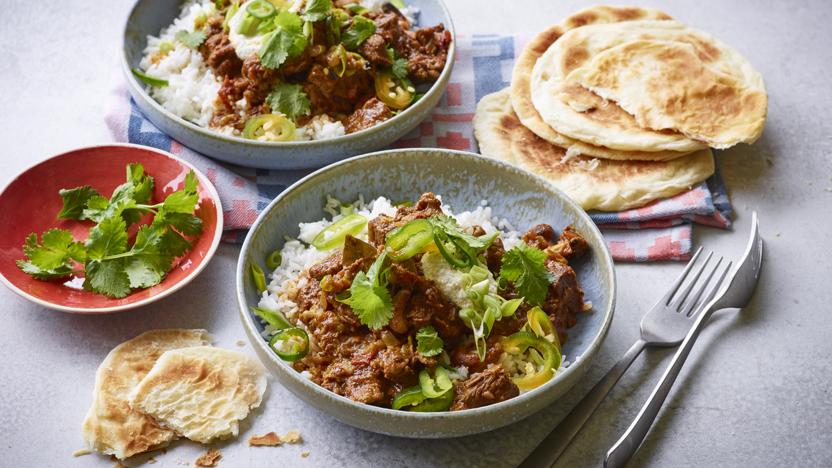Beef recipes
Beef varies tremendously in taste and quality depending on the age, breed, diet, lifestyle, slaughter and processing of the animal, so it's wise to choose and cook your meat carefully and to tailor the cut you buy to the dish you want to cook. Aberdeen Angus is a well-known good-quality breed of beef, but there are dozens of other breeds native to Britain or established for centuries. Native breeds include the Welsh Black, Highland, Lincoln Red, South Devon, Sussex and Hereford. Rare British breeds cover the Irish Moiled, Beef Shorthorn, Belted and Black Galloways, Red Poll, White Park, British White, Longhorn, Gloucester and Dexter.
An easy slow cooker beef stew that's ready when you are. Throw store cupboard ingredients into the slow cooker with some inexpensive braising steak and serve with mash.
Each serving (without mash) provides 293 kcal, 34g protein, 13g carbohydrates (of which 13g sugars), 11g fat (of which 4g saturates), 4g fibre and 2.5g salt.
More beef recipes
Buyer's guide
Look for beef that's firm to the touch. Avoid wet, slimy meat and meat with a greenish-grey tinge and an 'off' smell. Always check the 'use by' dates on pre-packed meat.
Colour is often cited as a means of determining the quality of beef, but it can't be used as the main indicator of quality. In general, meat that has been matured traditionally ('dry-aged') will tend to be deep burgundy in colour with creamy, yellowish fat. Meat that has been vacuum-packed shortly after slaughter will retain a bright-red appearance with white fat. This meat can still be tender but may lack the complexity of flavour of traditionally dry-aged beef. Brown colouring indicates the meat has been open to the air for too long. Most of the meat sold in supermarkets will be vacuum-packed and is seldom dry-aged for any length of time.
Many people prefer beef that's 'marbled' (flecked throughout) with fat. Marbled meat is considered to be more flavoursome and tender because the fat lubricates the meat during cooking and adds another layer of flavour. However leaner meat needn't be lacking in flavour if cooked properly.
Butchers are likely to stock a greater variety of cuts than most supermarkets and should be able to give advice on preparing and cooking, as well as telling you where, and from which breeds, their meat came from and for how long it has been aged. This level of detail should also be available from producers at farmers' markets and mail-order companies specialising in meat.
For organically-raised beef - or beef from breeds noted for their succulent meat, such as Aberdeen Angus - you should be prepared to pay more. Regardless, buying the best quality beef you can afford is always worthwhile.
Storage
Beef will keep for up to five days in the fridge, depending on how fresh it is when you buy it. Mince and offal are best eaten within two days. Vacuum-packed meat will normally last even longer, but check the use-by date to be sure.
Quickly freezing beef reduces the chance of damage to the texture of the meat. Use frozen beef within six months. Defrost, loosely wrapped, in the fridge allowing five hours per 450g (1lb). Never let the meat or its juices come into contact with other foods in the fridge, particularly ready-to-eat foods.
If you've cooked beef for eating later, cool it as quickly as possible (within 90 minutes), cover and refrigerate and eat within two days. Do not place hot into the fridge, which would risk raising the temperature of other foods that need to be kept cold.
Preparation
The larger the joint, the better it is for a traditional British roast. Choose a joint from the back, ribs, fillet or sirloin. Traditional roasting cuts are the forerib (known as rib of beef) or sirloin. Leaving in the bone adds flavour, and bone is a good conductor of heat so the meat will cook more evenly with the bone in. However, a boned and rolled cut is easier to carve.
A 2.5kg/5陆lb joint of beef on the bone (or 1.5kg/3lb 5oz boned and rolled joint) will feed six people generously. Preheat the oven to 190C/375F/Gas 5. For an extra flavoursome roast sear the beef in a hot pan for about 10 minutes before roasting (if you don't sear it first then add an extra 10 minutes to the following cooking times). Roast for 11 minutes per 450g/1lb (for rare), 14 minutes per 450g/1lb (for medium), and 16 minutes per 450g/1lb (for well done).
To be sure your meat is cooked you can use a meat thermometer. There are two varieties available - one you insert in the thickest part of the raw joint and cook until the desired internal temperature is reached. The other is inserted into the cooked joint after roasting. Recommended temperatures for beef are: Rare 60C; medium 70C; well done 80C. Baste the meat with the juices at least three times during cooking. When it's done, take out the meat and leave it to rest for at least 20 minutes. This enables the joint to re-absorb the delicious juices that have bubbled up and makes it easier to carve.
Brisket, thick flank, topside and silverside are all good cuts for braising or pot-roasting. The meat is usually dusted with flour and fried first to brown it, then placed on vegetables and herbs; stock is poured in to cover the meat. It's then cooked on a gentle heat in the oven with the lid on. The meat and vegetable juices combine to make a delicious sauce.
Stewing or casseroling is best for cheaper cuts that need long, gentle cooking such as shin and leg, brisket, chuck and blade, neck and clod and skirt. Many supermarkets sell packets of "stewing steak" that's likely to originate from the tougher cuts and which need longer cooking than cubes of "braising steak".



































